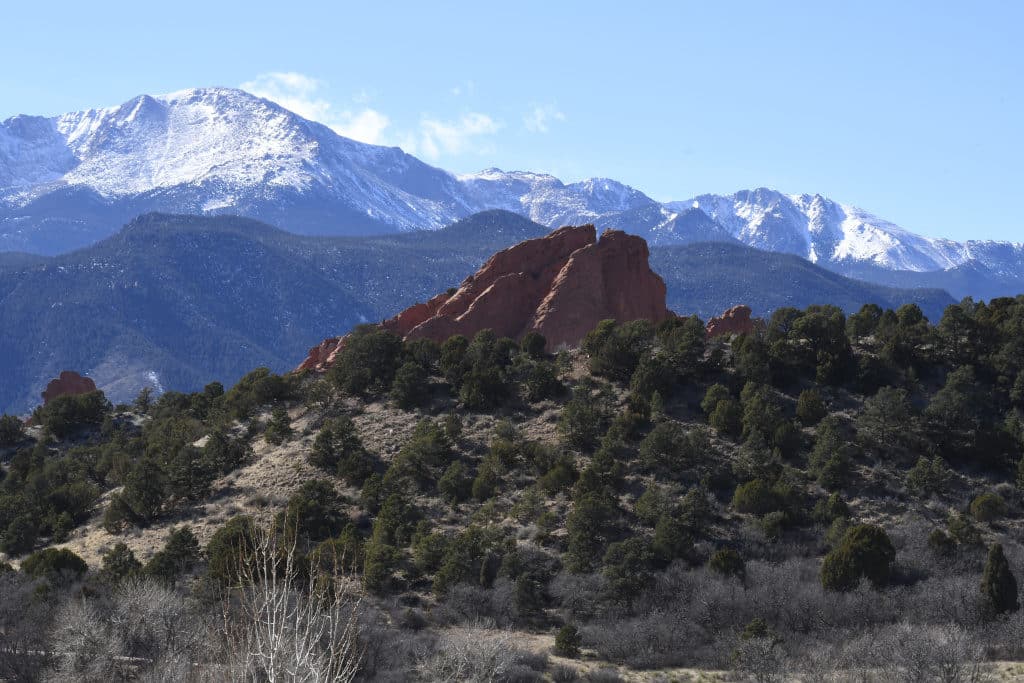We had the opportunity to leave the frigid conditions of Minnesota for a weekend in Colorado Springs, Colorado. One of the rarely spoken benefits to living up is that when traveling during the winter months, most destinations will have “warmer” weather. With daytime temperatures in the 50’s, the weather was downright balmy!
Our first stop was at the Garden of the Gods Visitor & Nature Center; we highly recommend that you make this your starting point. The first floor contains the park museum with multiple exhibit halls. Included in the exhibits is information covering the parks flora and fauna, history and people, geology and about the dinosaur Theiophytalia that made the park it’s home.
On the second floor, you will find an extensive gift shop, café, and outdoor balcony. You should plan on grabbing something to eat at the café (the seating area overlooks the park), especially if you have younger kids. The menu offers a selection of healthy, fun and tasty snacks/drinks.
TIP: Talk to the volunteers at the Visitor Center to not only learn more about the park but also get recommendations on the best places to hike and take pictures. They customized a map for us with the trails that would be best to visit for the amount of time we had to explore.
PHOTO TIP: When taking pictures from the balcony, if you have a new iPhone, switch to Portrait mode for images.
The origin story of the park goes back to 1859 when two surveyors were exploring the area, the first surveyor, M.S. Beach suggested that the area would make a “capital place for a beer garden”, upon hearing this the second surveyor, Rufus Cable exclaimed, “Beer Garden! Why it is a fit place for the Gods to assemble. We will call it the Garden of the Gods.”. In 1879, Charles Elliott Perkins, President of the Chicago, Burlington & Quincy Railroad purchased 240 acres for a summer home. He later added another 240 acres, but never built on the property, preferring to leave the area in its natural state.
Unfortunately, Mr. Perkins passed away before he was able to arrange for the land to become a public park. In 1909, his children deeded the property to the City of Colorado Springs, specifically adding language about its future use; “where it shall remain free to the public, where no intoxicating liquors shall be manufactured, sold, or dispensed, where no building or structure shall be erected except those necessary to properly care for, protect, and maintain the area as a public park.”.
The geology of the Gardens is composed of sedimentary rock layers from multiple periods in time. Some formations started off as massive sand dunes when Colorado existed as a windswept desert, while others are the results of material being washed down from the Ancestral Rockies.
Two notable time periods were the Lyons Formations (300-260 million years old), the outcroppings from this period are the largest in the park, and include the North and South Gateway, Gray Rock and Sleeping Giant. The Fountain Formation (320-300 million years old) period includes Balanced Rock, Sentinel Spires and Three Graces.
While you explore the park, bring a magnifying glass or a pocket magnifier to study the composition of the rocks up close. We use and recommend using a Bausch & Lomb Hastings Triplet magnifier (aka “Jeweler’s Loupes”) for studying minerals and rocks.
TIP: A great resource to talk about the geology of the park for students in grades 9-12 is the guide for the Garden of the Gods Geology Program
The Theiophytalia kerri dinosaur, originally discovered in 1886, was misidentified as a Camptosaurus and spent the next 100+ years at the Yale Musuem. In 1996, a cast was made of the fossil that was subsequently given to the park for an exhibit. It was not until 2006, when Dr. Ken Carpenter and Kathleen Brill reexamined the fossil and determined that it was actually a brand new genus and species.
For more information about the history and adventures of how the fossils were discovered and finally correctly identified, check out this article from the local newspaper.
As you explore the park, you will most like find climbers ascending the different formations. Each year, over 7,500 technical climbers register for the free Rock Climbing Permit with the city of Colorado Springs. This is a great time to discussing how climbers plan their routes. Check out the route guides by the Mountain Project to learn more about what is involved in planning a safe climb.
